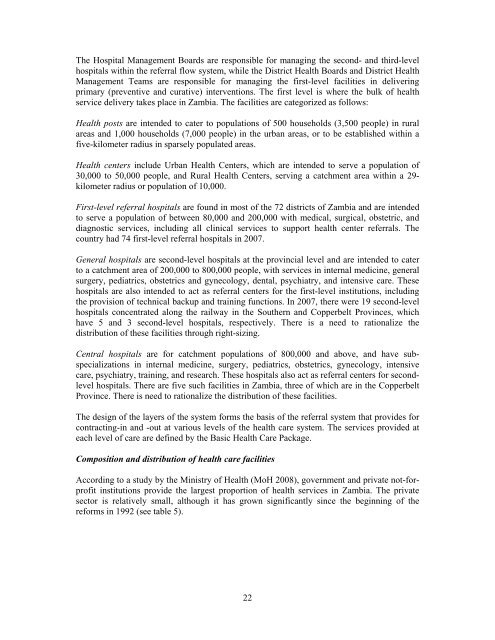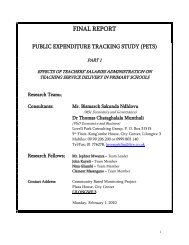Provider Purchasing and Contracting for Health Services_The Case
Provider Purchasing and Contracting for Health Services_The Case
Provider Purchasing and Contracting for Health Services_The Case
You also want an ePaper? Increase the reach of your titles
YUMPU automatically turns print PDFs into web optimized ePapers that Google loves.
<strong>The</strong> Hospital Management Boards are responsible <strong>for</strong> managing the second- <strong>and</strong> third-level<br />
hospitals within the referral flow system, while the District <strong>Health</strong> Boards <strong>and</strong> District <strong>Health</strong><br />
Management Teams are responsible <strong>for</strong> managing the first-level facilities in delivering<br />
primary (preventive <strong>and</strong> curative) interventions. <strong>The</strong> first level is where the bulk of health<br />
service delivery takes place in Zambia. <strong>The</strong> facilities are categorized as follows:<br />
<strong>Health</strong> posts are intended to cater to populations of 500 households (3,500 people) in rural<br />
areas <strong>and</strong> 1,000 households (7,000 people) in the urban areas, or to be established within a<br />
five-kilometer radius in sparsely populated areas.<br />
<strong>Health</strong> centers include Urban <strong>Health</strong> Centers, which are intended to serve a population of<br />
30,000 to 50,000 people, <strong>and</strong> Rural <strong>Health</strong> Centers, serving a catchment area within a 29-<br />
kilometer radius or population of 10,000.<br />
First-level referral hospitals are found in most of the 72 districts of Zambia <strong>and</strong> are intended<br />
to serve a population of between 80,000 <strong>and</strong> 200,000 with medical, surgical, obstetric, <strong>and</strong><br />
diagnostic services, including all clinical services to support health center referrals. <strong>The</strong><br />
country had 74 first-level referral hospitals in 2007.<br />
General hospitals are second-level hospitals at the provincial level <strong>and</strong> are intended to cater<br />
to a catchment area of 200,000 to 800,000 people, with services in internal medicine, general<br />
surgery, pediatrics, obstetrics <strong>and</strong> gynecology, dental, psychiatry, <strong>and</strong> intensive care. <strong>The</strong>se<br />
hospitals are also intended to act as referral centers <strong>for</strong> the first-level institutions, including<br />
the provision of technical backup <strong>and</strong> training functions. In 2007, there were 19 second-level<br />
hospitals concentrated along the railway in the Southern <strong>and</strong> Copperbelt Provinces, which<br />
have 5 <strong>and</strong> 3 second-level hospitals, respectively. <strong>The</strong>re is a need to rationalize the<br />
distribution of these facilities through right-sizing.<br />
Central hospitals are <strong>for</strong> catchment populations of 800,000 <strong>and</strong> above, <strong>and</strong> have subspecializations<br />
in internal medicine, surgery, pediatrics, obstetrics, gynecology, intensive<br />
care, psychiatry, training, <strong>and</strong> research. <strong>The</strong>se hospitals also act as referral centers <strong>for</strong> secondlevel<br />
hospitals. <strong>The</strong>re are five such facilities in Zambia, three of which are in the Copperbelt<br />
Province. <strong>The</strong>re is need to rationalize the distribution of these facilities.<br />
<strong>The</strong> design of the layers of the system <strong>for</strong>ms the basis of the referral system that provides <strong>for</strong><br />
contracting-in <strong>and</strong> -out at various levels of the health care system. <strong>The</strong> services provided at<br />
each level of care are defined by the Basic <strong>Health</strong> Care Package.<br />
Composition <strong>and</strong> distribution of health care facilities<br />
According to a study by the Ministry of <strong>Health</strong> (MoH 2008), government <strong>and</strong> private not-<strong>for</strong>profit<br />
institutions provide the largest proportion of health services in Zambia. <strong>The</strong> private<br />
sector is relatively small, although it has grown significantly since the beginning of the<br />
re<strong>for</strong>ms in 1992 (see table 5).<br />
22
















